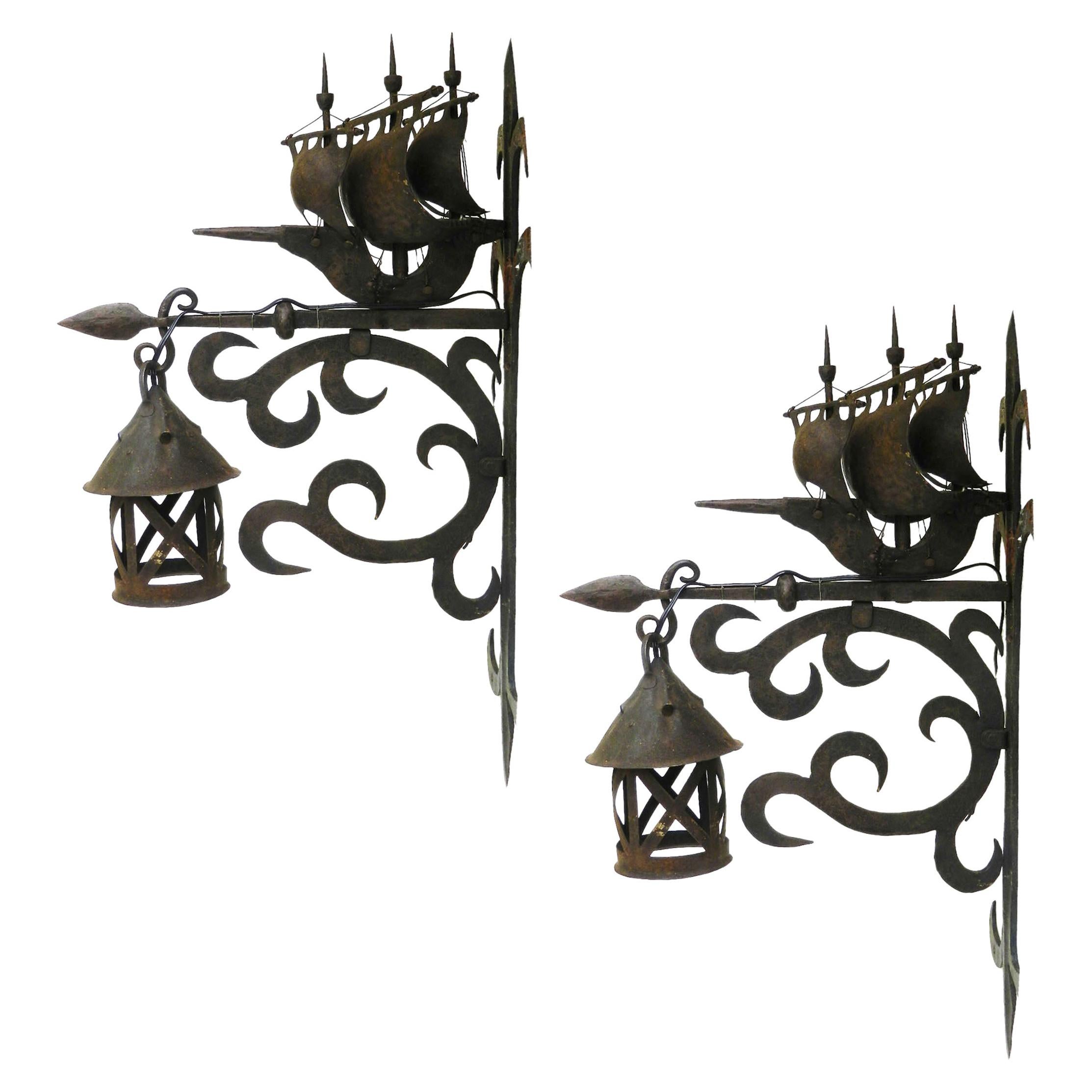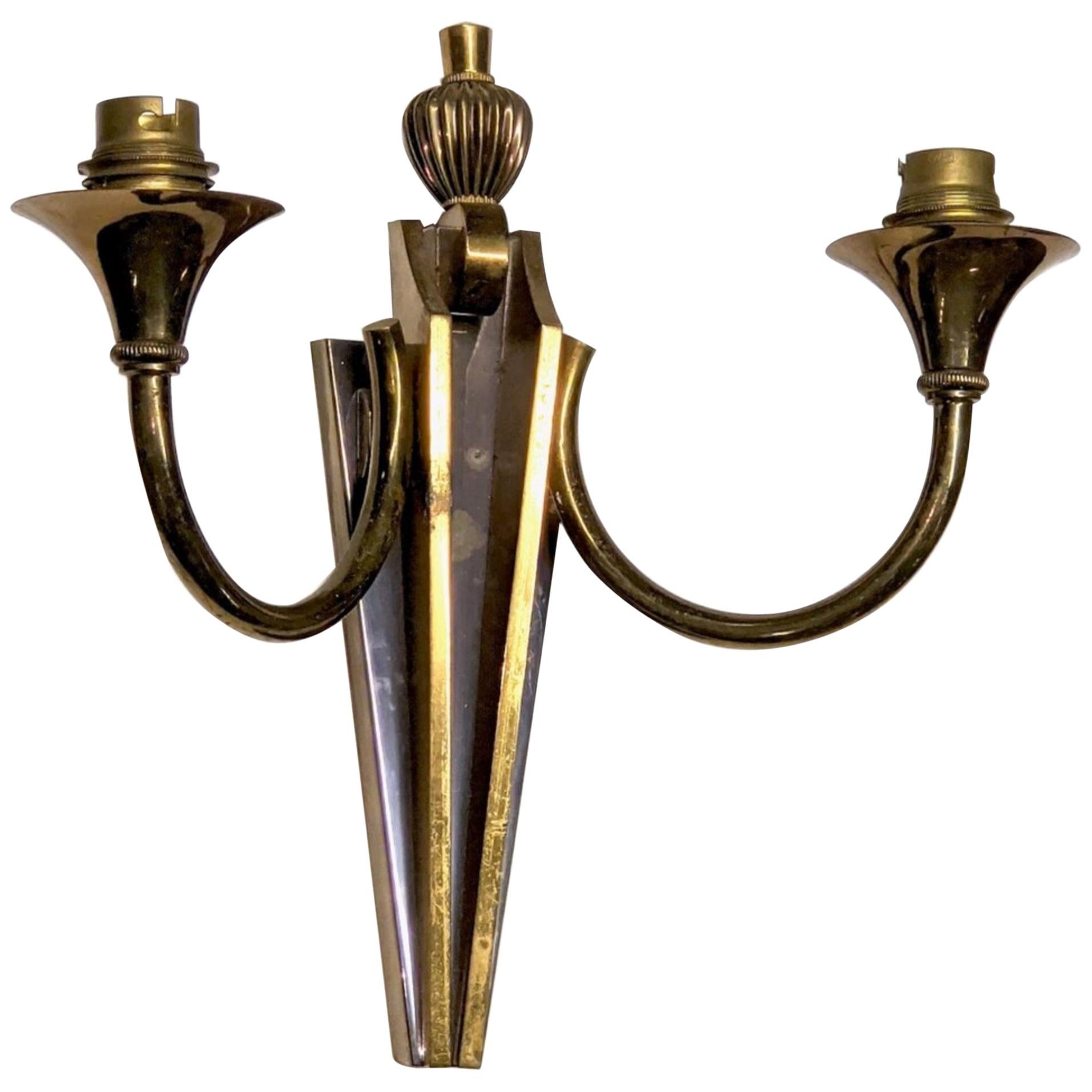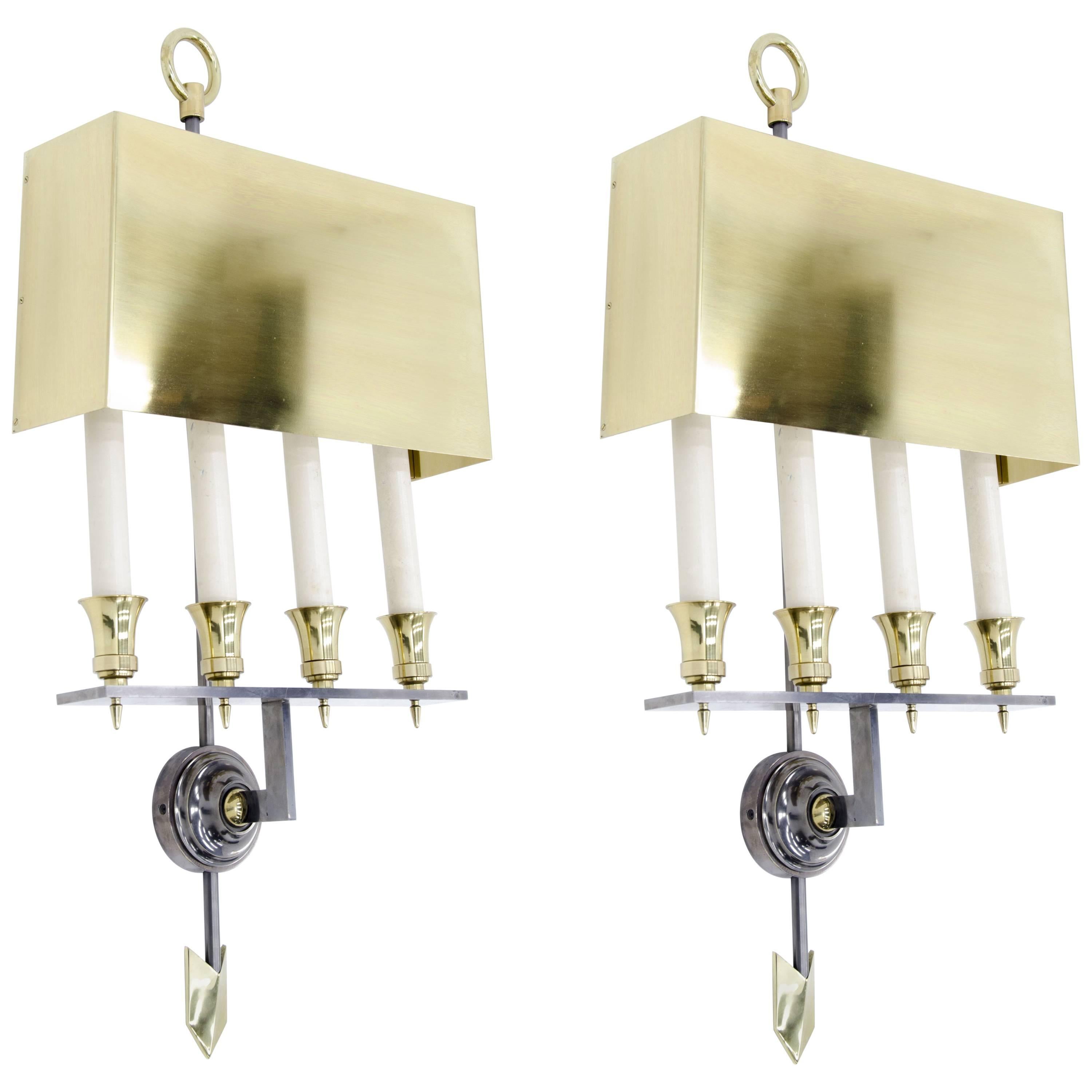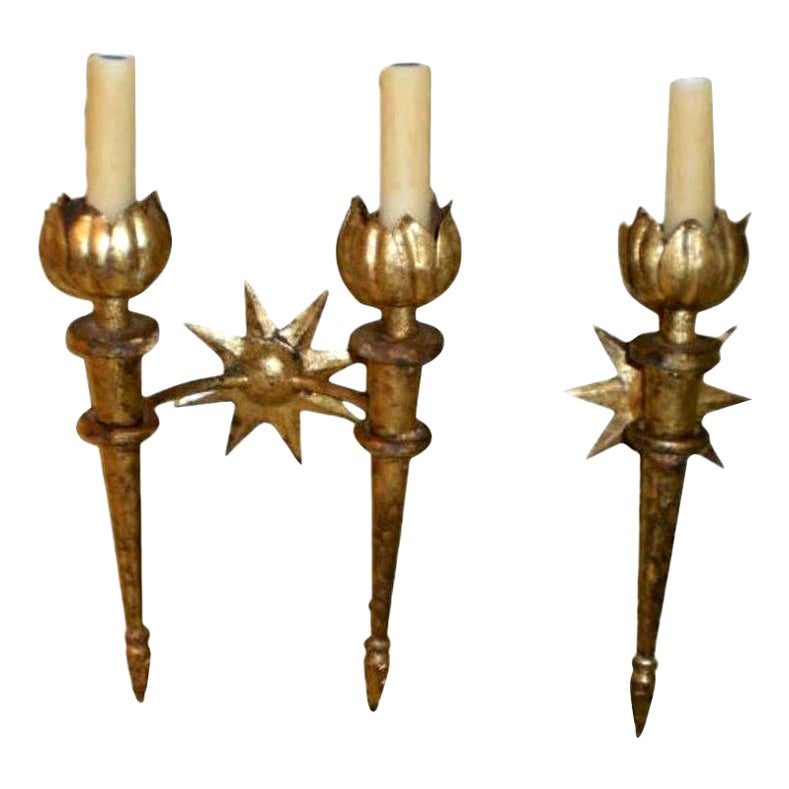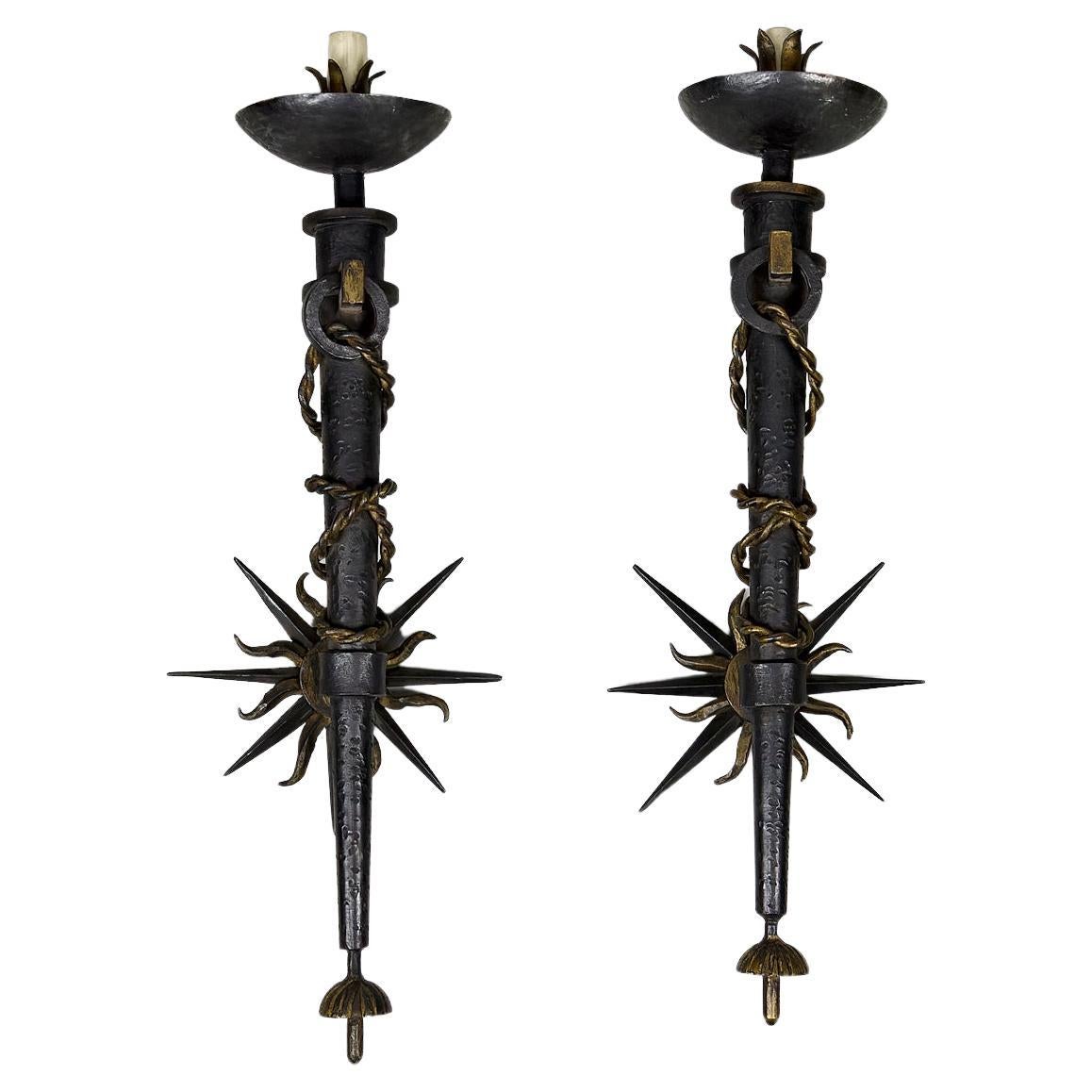Items Similar to Sconce Art Deco, 1930, "Attributed to Gilbert Poillerat", France
Video Loading
Want more images or videos?
Request additional images or videos from the seller
1 of 7
Sconce Art Deco, 1930, "Attributed to Gilbert Poillerat", France
About the Item
Style: Art Deco
Material: iron and wood
Country: France
We have specialized in the sale of Art Deco and Art Nouveau and Vintage styles since 1982. If you have any questions we are at your disposal.
Pushing the button that reads 'View All From Seller'. And you can see more objects to the style for sale.
"Attributed Gilbert Poillerat"
There have been many important French designers associated with Art Deco and through the 1930’s, ’40’s and beyond who worked in wrought iron. One usually thinks of Edgar Brandt, Raymond Subes, and Paul Kiss. For quite a while, when Art Deco was enjoying its first flush of recognition in the 1970’s, Gilbert Poillerat remained relatively unknown. This would soon change as the natural progression of design exploration began to move into the 1930’s and beyond, and Poillerat would emerge as one of the most original and important designers of his time.
Gilbert Poillerat was born in 1902 in a small town in France that, oddly, had three names – Mer, Loir et Cher. Like many other furniture designers, he attended the famed École Boulle, where he trained as a metal chiseler and engraver, graduating in 1921.
Following his graduation, he worked with arguably the best and most influential wrought-iron master – Edgar Brandt. He worked for Brandt for over seven years in both design and production. There can be no doubt that this time was hugely important, not only in furthering his training and perfecting his technique, but also exposing him to the new ideas that had blossomed forth during the Art Deco movement, when wrought-iron escaped the constraints of tradition that had kept it static for so long.
In 1927, Poillerat left Brandt, and began working for Baudet, Donon and Roussel, a firm specializing in construction frameworks. He was placed in charge of their decorative iron-work division, which produced tables, screens, grilles, andirons and lighting. This was the perfect opportunity to hone his skills, and also to evolve his own styles.
In 1928, he first exhibited at the salon d’Automne.
Art. Nouveau
The name "Art Nouveau" in French means "new art". It is also known as Jugendstil in Germany. In contrast, in Vienna and in Italy, "Liberty style". The Art Nouveau designs used curvilinear sinuous asymmetrical lines, often based on plant forms. and feminine silhouettes. The style was used in architecture, interior design, glass, jewelry, sculpture, painting, posters and illustration. Introduced new materials such as opals and semi-precious stones Art Nouveau had its greatest impetus in the 1900 Universal Exhibition in Paris. After that, it spread throughout Europe, USA and Australia In Paris you can see the entries in metro are of Hector Guimard and Émile Gallé. Some artists are: Gustav Klimt, Charles Rennie Mackintosh, Alphonse Mucha, René Lalique, Antoni Gaudí and Louis Comfort Tiffany. Victor Horta had a decisive impact on architecture in Belgium. Each of them interpreted it their way.
Why are there so many antiques in Argentina?
In the 1880 – 1940 there was a grate wave of immigration encouraged by the periods of war that were taking place.
1st World War took place between 1914 and 1918
2nd World War took place between 1939 and 1945
The immigrants options were New York or Buenos Aires. Tickets were cheap and in Buenos Aires they were welcomed with open arms, as it was a country where everything was still to be done.
Argentina was the country of new opportunities, labour was needed and religious freedom was assured, in many cases the of the family travel first until they were settled and then the rest of the family members join them.
In the immigrant museum “Ellis Island Immigrant Building” in New York you can se the promotional posters of the boats that would take them to a new life.
Between the years 1895 and 1896, Argentina had the highest DGP (gross domestic product) per capita in the world according to the Maddison Historical Statistics index, this situation arose due to the large amount of food being exported to European countries, which were at war.
The Argentinean ships left the port of Buenos Aires with food, but they returned with furniture, clothes and construction elements, (it´s common to see this the old buildings of the historic neighbourhood of San Telmo, the beams with the inscription “Made in England)”, as well as many markets that were built in Buenos Aires, such us the San Telmo Market, whose structure was brought by ship and afterwards assembled in 900 Defensa Street.
With the great influence of European immigrants living in the country, the children of the upper classes travelled to study in France, resulting in the inauguration of “La Maison Argentinienne”, on 27th of June 1928, in the international city of Paris, which hosted many Argentinians that were studying in Frace.
It´s the fourth house to be built after France, Canada and Belgium, being the first Spanish-speaking one. Still in place today (17 Bd Jourdan, 75014, Paris, France). Many of the children of these wealthy families who attended international art exhibitions, museums and art courses abroad, took a keen interest in the European style. This is why Buenos Aires was at the time referred as “The Paris of South America”.
Between the years 1890 and 1920 more than a hundred Palaces were built on Alvear Avenue the most exclusive avenue in Buenos Aires. Today some of these palaces have been transformed into museums, hotels and embassies.
In the year 1936, the Kavanagh building was inaugurated, it was the tallest reinforced concrete building in South America.
During 1994 the American Society of Civil Engineers distinguished it as an “international engineering milestone”, and it´s now considered a World Heritage of Modern Architecture.
At the time was common to hire foreign architects such as Le Corbusier, who visited Buenos Aires/Argentina in 1929 and in 1948 he drew up the blueprints for a house built in La Plata City (which was declared a World Heritage Site).
In 1947, the Hungarian architect Marcelo Breuer designed “Parador Ariston” in the seaside city of Mar del Plata. After an Argentinean student at Harvard University convinced him to come to Argentina. He worked on an urban development project in the Casa Amarilla, area of La Boca.
The Ukrainian architect, Vladimiro Acosta, arrives in Argentina in 1928 and worked as an architect until que moved to Brazil.
Antonio Bonet, a Spanish architect who worked with Le Corbusier in Paris, arrives in Argentina in 1937, where he carried out several architectural works and in 1938 designs the well-known BFK chair.
Andres Kálnay, of Hungarian origin, made around 120 architectural masterpieces, among which the former Munich brewery stands out, he even made the furniture’s design.
The German architect, Walter Gropius, director of the Bauhaus, lived in Argentina, where he wrote articles for “Sur” magazine and founded in Buenos Aires, an architectural firm with Franz Möller, who was also an architect, where he built two houses.
At the same time several famous designers decided to immigrate to Argentina, among them we can find the well-known French designer, Jean-Michel Frank, who arrived in the country in 1940 and also worked for the Rockefeller family.
Special pieces were made, which were sold exclusively in the country, such as the well-known German company “WMF”, who sold their products by catalogue, which were chosen by the ladies of high society in the list of wedding gifts, as well as the pieces designed by Christofle.
The Swiss sculptor Alberto Giacometti, made special pieces for Argentinean mansions.
In 1904 the first Jansen branch outside Paris was established in Buenos Aires, as the Argentinean clientele demanded a large amount of furniture, from the end of the 19th century to the mid-20th century.
In 1970, the brand Rigolleau Argentina made pieces authorised by Lalique.
The brands Maple and Thompson also set up shop in the country.
The French plastic artist, Marcel Duchamp moved to Argentina in 1918-1919.
Glass signed Gallé, Charder, Leverre, Schneider, Muller and other French firms. They were bought in flower shops and were given to ladies with beautiful floral arrangements.
Some furniture manufacturers travelled to international fairs and bough the patterns to produce the furniture in Argentina, such as the furniture firm Englander and Bonta, who bought the patterns ins Italy.
It is worth mentioning that in Argentina we have the largest community of Italians outside of Italy, as it is estimated that 70 percent of the inhabitants have at least one Italian descendant, followed by Spanish immigrants.
The most Important furniture stores in Argentina:
Comte is founded in 1934 (under the direct management of Jean Michel Frank in 1940).
Nordiska (Swedish company established in 1934).
Churba in 1960, a company that brought foreign designers to present their furniture in the country:
Denmark: (Arne Jacobsen, Finn Juhl, Bender Madsen, Ejner Larsen, Poul Kjaerholm, Hans Wegner)
Sweden: (Hans Agne Jakobsson, Gustavsberg)
United States: (Herman Miller)
Finland: (Lisa Johansson, Folke Arstrom, Tapio Wirkkala, Alvar Aalto, Timo Sarpaneva)
Swedish Factory: (Orrefors)
Italy: (Littala, Vico Magistretti, Emma Gismondi, Gae Aulenti, Angelo Mangiarotti, Elio Martinelli, Gianna Celada, Angelo Mangiarotti, Mario Bellini, Carlo Scarpa)
Finland: (Olivia Toikka)
Plata Lappas (Lappas Silver): a goldsmith shop founded in 1887 in Argentina by Alcibiades Lappas of Greek origin.
In 2019, in Argentina took place “the Art Deco world congress”, in which we participated as hosts invited by Geo Darder, founder of the Copperbridge – Foundation, in which prominent people from all over the world attended to learn about Art Deco in Argentina.
Argentina currently has more than 100 Art Deco buildings and another 90 Art Nouveau buildings throughout the city of Buenos Aires.
Argentina is a country that has not been involved in many wars, which is why it has been a refuge for works of art and antiques from different periods of time, unlike European countries. That is way many collectors, museums and antique dealers from all over the world visit it, you should not miss the opportunity to visit this great country.
Laura Guevara Kjuder, architect.
- Attributed to:Gilbert Poillerat (Artist)
- Dimensions:Height: 27.56 in (70 cm)Width: 5.52 in (14 cm)Depth: 9.85 in (25 cm)
- Power Source:Hardwired
- Voltage:220-240v
- Style:Art Deco (Of the Period)
- Materials and Techniques:
- Place of Origin:
- Period:
- Date of Manufacture:1930
- Condition:Wear consistent with age and use.
- Seller Location:Ciudad Autónoma Buenos Aires, AR
- Reference Number:
About the Seller
5.0
Vetted Seller
These experienced sellers undergo a comprehensive evaluation by our team of in-house experts.
Established in 1982
1stDibs seller since 2022
21 sales on 1stDibs
Typical response time: <1 hour
- ShippingRetrieving quote...Ships From: Ciudad Autónoma Buenos Aires, Argentina
- Return PolicyThis item cannot be returned.
More From This SellerView All
- Bar Art Deco, France, 'Parchament Leather', Attributed to: Gilbert PoilleratBy Gilbert PoilleratLocated in Ciudad Autónoma Buenos Aires, CBar Art deco attributed to: Gilbert Poillerat Material: Parchament leathe , Gilded iron, wood, mirror Style: Art Deco Country: France If you want to live in t...Category
Vintage 1920s French Art Deco Dry Bars
MaterialsIron
- 4 Sconces in Alabaster, France , 1930, Style: Art DecoLocated in Ciudad Autónoma Buenos Aires, CMonumental Art Deco sconces in alabaster, 74 cm high (alabaster light). Size height: 29.14 in. Style: Art Deco Year: 1930 Wall light in Material: Alabaster and Chrome Chic and Elega...Category
Vintage 1930s French Art Deco Wall Lights and Sconces
MaterialsAlabaster, Chrome
- Sconce, French in Glass and Chrome, Style, Art Deco, 1930Located in Ciudad Autónoma Buenos Aires, CSconce Art Deco, French Style: Art Deco Country. French We have specialized in the sale of Art Deco and Art Nouveau and Vintage styles since 1982. If you have any questions we are a...Category
Vintage 1930s French Art Deco Wall Lights and Sconces
MaterialsChrome
- Big Sconce, Style: Art Deco, Year: 1930, Design: Sabino, FranceBy Marius-Ernest SabinoLocated in Ciudad Autónoma Buenos Aires, CSconce Marius Ernest Sabino Style: Art Deco Year: 1930 Wall light in Material: Silvered bronze and glass Chic and Elegant To take care of your property and the lives of our customers...Category
Vintage 1930s French Art Deco Wall Lights and Sconces
MaterialsArt Glass
- Sconce, French in Glass and Chrome, Style, Art Deco, 1930Located in Ciudad Autónoma Buenos Aires, CSconce Art Deco, French Style: Art Deco Country. French We have specialized in the sale of Art Deco and Art Nouveau and vintage styles since 1982. If you are looking for an chandeli...Category
Vintage 1930s French Art Deco Wall Lights and Sconces
MaterialsChrome
- 4 Sconces in Glass and Iron, Style, Art Deco, Year, 1930, FranceLocated in Ciudad Autónoma Buenos Aires, C2 Sconces Style: Art Deco Year: 1930 Wall light in material: iron and glass To take care of your property and the lives of our customers, the new wiring has been done. If you want t...Category
Vintage 1930s French Art Deco Wall Lights and Sconces
MaterialsIron
You May Also Like
- 2 Wrought Iron Sconces Attributed to Poillerat Marine Galleon, circa 1930By Gilbert PoilleratLocated in Mimizan, FRPair Sconces Wrought Iron one of a kind attributed to Gilbert Poillerat, circa 1930 Rare and unique from Atelier Poillerat With midcentury Arts & Crafts Neo Baroque influences typica...Category
Mid-20th Century French Baroque Revival Wall Lights and Sconces
MaterialsWrought Iron, Iron
- Gilbert Poillerat Three Two-Branch SconcesBy Gilbert PoilleratLocated in Philadelphia, PAFrench 1940s Art Deco three two-branch sconces by Gilbert Poillerat. Available singly or pair or group. Bronze and patinated bronze. Measures: 12.5” wid...Category
Vintage 1930s French Art Deco Wall Lights and Sconces
MaterialsBronze
- Pair of Sconces by Gilbert PoilleratBy Gilbert PoilleratLocated in New York, NYPair of sconces by Gilbert Poillerat, circa 1960s in brass and steel (canon de fusil).Category
Vintage 1960s French Mid-Century Modern Wall Lights and Sconces
MaterialsBrass, Steel
- 4 French Midcentury Modern Neoclassical Gilt Iron Sconces, Gilbert PoilleratBy Gilbert PoilleratLocated in New York, NYTwo pairs of French Mid-Century Modern Neoclassical, gilt iron wall lights in the style of Gilbert Poillerat, each with double arms. Price and Sold as Individual Pieces.Category
Mid-20th Century French Mid-Century Modern Wall Lights and Sconces
MaterialsIron
- Set of French Gilt Iron Sconces After Gilbert PoilleratBy Maison Jansen, Maison Baguès, Maison Charles, Maison Raphael, Gilbert PoilleratLocated in Houston, TXSet of French gilt iron sconces after Gilbert Poillerat. Stunning pair of French gilt iron sconces in the manner of Gilbert Poillerat. These fantastic torch form sconces have a beau...Category
Vintage 1940s French Hollywood Regency Wall Lights and Sconces
MaterialsIron
- Pair of torchiere sconces in wrought iron by Gilbert Poillerat, France, 1940'sBy Gilbert PoilleratLocated in VÉZELAY, FRPair of torch/torchiere sconces. In patinated and partially gilded wrought iron, the cone-shaped body decorated with a cord, completed by a smei-spherical cup at the top and a gadroo...Category
Vintage 1940s French Art Deco Wall Lights and Sconces
MaterialsMetal, Wrought Iron
Recently Viewed
View AllMore Ways To Browse
Gilbert Gilbert
Gilbert A
Gilbert Used Furniture
A Gilbert
Deco Plant
Semi Precious Stones Art
Vintage Wall Art 1930
Vintage Childrens Wall Art
Art Deco Made In Usa
Gilbert Art Deco
Deco Vintage Salon
Deco Salon Vintage
Deco Train
Art Deco Silhouette
French Art Deco Masters
French Vintage Australia
Art Deco Train
70s Wall Art
